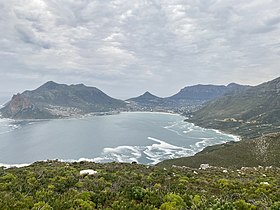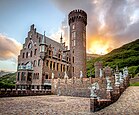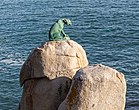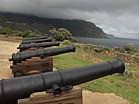Hout Bay | |
|---|---|
|
From top, a view of Hout Bay from Chapman's Peak. Hout Bay beach (left), Lichtenstein Castle (right), Bronze Leopard located in the south access to Hout Bay (left), East Fort Battery, Hout Bay (right). Hout Bay 2014 06.jpg | |
| Coordinates: 34°2′S 18°21′E / 34.033°S 18.350°E | |
| Country | South Africa |
| Province | Western Cape |
| Municipality | City of Cape Town |
| Main Place | Cape Town |
| Government | |
| • Type | Ward 74 |
| • Councillor | Roberto Quintas (DA) |
| Area | |
| • Total | 28.38 km2 (10.96 sq mi) |
| Population (2011)[1] | |
| • Total | 33,440 |
| • Density | 1,200/km2 (3,100/sq mi) |
| Racial makeup (2011) | |
| • Black African | 46.2% |
| • White | 30.8% |
| • Coloured | 19.0% |
| • Indian/Asian | 0.5% |
| • Other | 3.5% |
| First languages (2011) | |
| • English | 36.6% |
| • Xhosa | 28.3% |
| • Afrikaans | 19.6% |
| • Zulu | 1.8% |
| • Other | 13.6% |
| Time zone | UTC+2 (SAST) |
| Postal code (street) | 7806 |
| PO box | 7872 |
| Area code | 021 |
Hout Bay (Afrikaans: Houtbaai, meaning "Wood Bay") is a seaside suburb of Cape Town in the Western Cape province of South Africa. It is situated in a valley on the Atlantic seaboard of the Cape Peninsula, twenty kilometres south of the Central business district of Cape Town. The name "Hout Bay" can refer to the town, the bay on which it is situated, or the entire valley.
The area was originally made up of two farms, which were slowly subdivided to make way for urban expansion. While still maintaining its rural atmosphere, the area of Hout Bay has more than 5,960 residences inhabited by a population of at least 17,900 people (as of 2011).[1]







